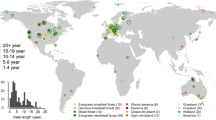Abstract
Time dependent carbon transfer coefficients are estimated using ecosystem exchange data by minimizing over variable observational intervals, Kalman filter, and variational minimization techniques. Transfer coefficients are determined by application of estimation procedures to subintervals from a partition of the observational time period, minimizing the variance of analyzed errors without the imposition of a priori transfer coefficient models in Kalman filters, and minimization with respect to transfer coefficients in variational fit-to-data functionals. Results are compared between methods and seasonal variability is observed in the transfer coefficients.
Similar content being viewed by others
References
D. D. Baldocchi, Assessing the eddy covariance technique for evaluating carbon dioxide exchange rates of ecosystems: Past, present and future, Global Change Biol, 2003, 9: 479–492.
A. S. Kowalski, M. Sartore, R. Burlett, P. Berbigier, and D. Loustau, The annual carbon budget of a French pine forest (Pinus pinaster) following harvest, Global Change Biol, 2003, 9(7): 1051–1065.
K. L. Clark, W. P. Cropper, and H. L. Gholz, Evaluation of modeled carbon fluxes for a slash pine ecosystem: SPM2 simulations compared to eddy flux measurements, Forest Sciences, 2001, 47: 52–59.
B. E. Law, M. Williams, P. M. Anthoni, et al., Measuring and modeling seasonal variation of carbon dioxide and water vapour exchange of a Pinus ponderosa forest subject to soil water deficit, Global Change Biol, 2000, 6(6): 613–630.
Y. Luo, B. Medlyn, D. Hui, et al., Gross primary productivity in Duke forest: modeling synthesis of CO2 experiment and eddy-flux data, Ecological Applications, 2001, 11: 239–252.
D. Hui, Y. Luo, and G. Katul, Partitioning inter-annual variability in net ecosystem exchange between climatic variability and function changes, Tree Physiology, 2003, 23: 433–442.
J. M. Gove and D. Y. Hollinger, Application of a dual unscented Kalman filter for simulataneous state and parameter estimation in problems of surface-atmosphere exchange, Journal of Geophysical Research-Atmospheres, 2006, D08s07, 111.
L. White and Y. Luo, Model-Based assessment for terrestrial carbon processes: Implications for sampling strategies in face experiments, Applied Mathematics and Computation, 2005, 167: 419–434.
L. White, Y. Luo, and T. Xu, Carbon sequestration: Inversion of face data and prediction, Applied Mathematics and Computation, 2005, 166: 783–800.
L. White, F. White, T. Xu, and Y. Luo, Estimation of parameters in carbon sequestration models from net ecosystem exchange data, Applied Mathematics and Computation, 2006, 181: 864–879.
L. White and Y. Q. Luo, Modeling and inversion of net ecological exchange data using an ito stochastic differential equation approach, Applied Mathematics and Computation, 2008, 196(2): 686–704.
J. D. Annan, D. J. Lunt, J. C. Hargreaves, and P. J. Valdes, Parameter estimation in an atmospheric GCM using the ensemble Kalman filter, Nonlinear Processes in Geophysics, 2005, 12: 363–371.
C. Bishop, B. Etherton, and S. Majumdar, Adaptive sampling with the ensemble transform kalman gilter, Part I: Theoretical Aspect, Monthly Weather Review, 2001, 129: 420–436.
M. Chen, S. Liu, and L. Tieszen, State-parameter estimation of ecosystem models using a smoothed ensemble kalman filter, preprint.
G. Evensen, The ensemble Kalman filter: Theoretical formulation and practical implementation, Ocean Dynamics, 2003, 53: 343–367.
L. White and A. Shapiro, Radar network scanning coordination based on ensemble transform kalman filtering variance optimization, Applied Mathematics and Computation, 2007, 188(5): 1285–1309.
Ian Rhodes, A tutorial introduction to estimation and filtering, IEEE Trans. on Automatic Control, 1971, 16(6): 688–706.
D. Y. Hollinger and A. D. Richardson, Uncertainty in eddy covariance measurements and its application to physiological models, Tree Physiology, 2005, 25: 873–885.
A. D. Richardson, D. Y. Hollinger, G. G. Burba, et al., A multi-site analysis of random error in tower-based measurements of carbon and energy fluxes, Agricultural and Forest Meteorology, 2006, 136: 1–18
T. C. Gard, Introduction to Stochastic Differential Equations, Marcel Dekker, Inc., New York, 1988.
P. E. Kloeden and E. Platen, Numerical Solutions of Stochastic Differential Equations, Springer, New York, 1999.
W. Rumelin, Numerical treatment of stochastic differential equations, SIAM J. Numerical Anal., 1982, 19: 604–613.
I. I. Gihman and A. V. Skorohod, Stochastic Differential Equations, Springer-Verlag, New York, 1972.
B. Oksendal, Stochastic Differential Equations, Springer, New York, 2000.
A. Tarantola, Inverse Problem Theory, SIAM, Philadelphia, 2005.
H. Niederreiter, Random Number Generation and Quasi-Monte Carlo Methods, SIAM, Philadelphia, 1992.
M. R. Raupach, P. J. Rayner, D. J. Barrett, et al., Model-data synthesis in terrestrial carbon observation: methods, data requirements and data uncertainty specifications, Global Change Biolog, 2005, 1: 378–397.
M. Williams, et al., An analysis of forest carbon dynamics using data assimilation, Global Change Biology, 2005, 11: 89–105.
M. Schultz, Spline Analysis, N. J. Englewood Cliffs, Prentice Hall, 1973.
Y. L. Luo, L. White, J. Canadell, et al., Sustainability of terrestrial carbon sequestration: A case study in Duke Forest with an inversion approach, Global Biogeochemical Cycles, 2003, 17(1): 21–34.
Author information
Authors and Affiliations
Corresponding author
Rights and permissions
About this article
Cite this article
White, L. Estimation of time dependent carbon transfer coefficients using net ecosystem exchange data. J Syst Sci Complex 23, 640–664 (2010). https://doi.org/10.1007/s11424-010-0150-y
Received:
Revised:
Published:
Issue Date:
DOI: https://doi.org/10.1007/s11424-010-0150-y




